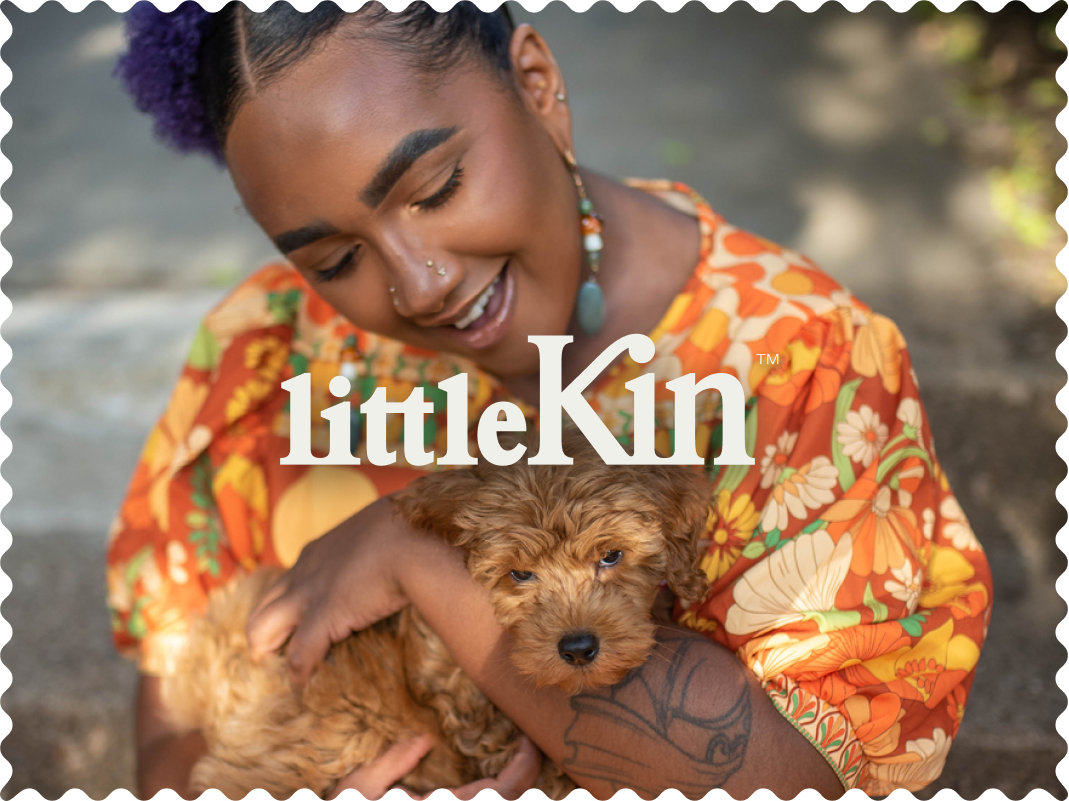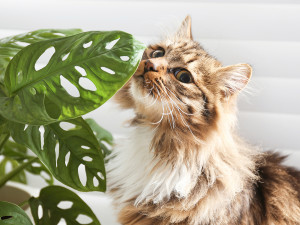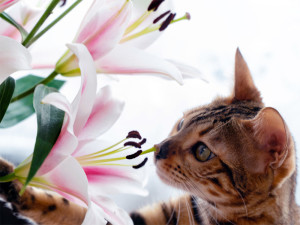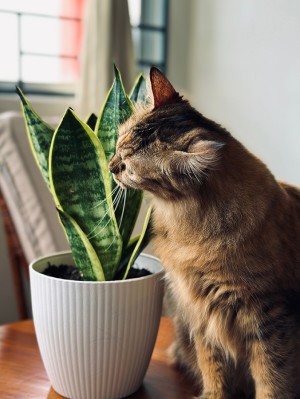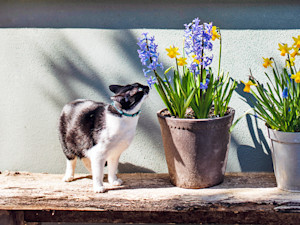Are Dandelions Poisonous to Cats?
Spoiler alert: those ‘weeds’ are actually pretty harmless

Share Article
In this article:
What are dandelions?opens in new tab Can cats eat dandelions?opens in new tab Dandelion benefitsopens in new tab How many dandelions can cats eat?opens in new tab Dandelion reactionsopens in new tab Plants that are toxic to catsopens in new tab Why do cats eat plants?opens in new tab FAQsopens in new tab
If you’re a cat parent in the UK, you’ve probably spotted your feline friend batting at dandelions in the garden or giving those bright yellow flowers a curious sniff. These cheerful plants can be found almost anywhere – from pristine lawns to neglected corners of car parks – and they seem to have a magnetic pull on our cats.
But here’s the thing: watching your cat investigate (or straight-up munch on) dandelions can leave you wondering whether you should be panicking or not. Are these ubiquitous yellow flowers actually dangerous for cats? Let’s get into what you need to know about dandelions and your cat’s safety.
What are dandelions?
Dandelions (Taraxacum officinale) are perennial herbs that grow almost everywhere in the UK. They’re well-known for their bright yellow flowers, which turn into those iconic white puffballs that kids love to blow on.
Despite their reputation as weeds, dandelions are quite useful. They’re edible for humans and have been used for centuries in traditional medicine. People use dandelion leaves in salads, the roots can be brewed into a tea, and they’re thought to have various health benefits, for both humans and cats.
Can cats eat dandelions?
While dandelions aren’t toxic to cats, the saying “you can have too much of a good thing” definitely applies here. In large quantities, their fibrous content can upset your cat’s stomach, as felines are obligate carnivores, meaning their digestive systems simply aren’t built for processing a lot of plant matter.
It’s also worth noting that many wild dandelions, especially those growing near roadsides or verges, may have been sprayed with weed killers or other chemicals that are extremely dangerous to pets. Those growing near railways can accumulate harmful levels of heavy metals. Always ensure any dandelions your cat might encounter are chemical-free.
6 (potential) benefits of feeding dandelions to your cat
Dandelions are packed with vitamins A, B1, C, D and K, as well as minerals like iron, calcium, magnesium, potassium and phosphorus. They also contain other natural compounds that may promote health. While the evidence for their benefits in cats is largely anecdotal or based on human studies, the potential is certainly intriguing.
Here are some of the reasons why dandelions might be a healthy addition to your cat’s diet, in moderation:
1. Aids digestion
Dandelions contain inulin, a type of prebiotic fibre that can help improve gut health by encouraging beneficial bacteria. Their natural fibre content may also assist with regular bowel movements and help prevent constipation.
2. Boosts immune function
These plants are thought to have antiviral and antibacterial properties. The vitamins they contain, especially A and C, are important for immune system health. And since gut health is closely linked to immune function, the prebiotics in dandelions may give your cat an added boost.
3. Natural anti-inflammatory
Dandelions are packed with natural compounds that can help calm inflammation. They contain things like flavonoids and polyphenols, which are thought to help regulate the immune system and reduce the body’s inflammatory response. These substances may work by blocking certain signals in the body that trigger inflammation in the first place.
4. Promotes healthy fur and skin
The high levels of vitamins in dandelions may contribute to shinier fur and healthier skin. When included as part of a balanced diet, they could help your cat maintain a glossy, healthy coat.
5. Natural diuretic
Some sources suggest dandelions act as a gentle diuretic, which could help reduce water retention. However, the evidence for this is limited, and they should never be used as a substitute for prescribed medications, particularly in cases like heart failure, where potent diuretics are required.
6. Can support liver detoxification
Dandelions may aid the liver in eliminating toxins, which is useful for cats with liver stress. That said, they are not a replacement for veterinary treatment or medications in cases of diagnosed liver disease.
How many dandelions can cats eat?
There’s no strict measurement for how much is ‘safe’, but moderation is key. Think of dandelions as the feline equivalent of a small side salad – a few leaves here and there won’t hurt, but don’t let your cat turn them into a main course. If you‘re considering any supplements to your cat‘s diet, speak to your vet first.
What to do if your cat has a bad reaction
Dandelions themselves are not toxic, so if your cat becomes unwell after eating one, there may be another cause. They could have eaten a dandelion that had been sprayed with chemicals, had an allergic reaction, or simply be unwell for unrelated reasons.
Cats are very good at hiding symptoms of illness, so any noticeable changes in their behaviour or health should be taken seriously. If in doubt, always consult your vet as soon as possible.
Plants that are toxic to cats
Now, while dandelions get the all-clear, plenty of other common plants absolutely don’t. Lilies are one of the worst offenders, just brushing against the pollen can cause fatal kidney damage. Others to watch out for include foxgloves, daffodils, tulips, hyacinths and chrysanthemums. Even some houseplants such as peace lilies and pothos can be toxic. It’s a good idea to double-check what’s growing in your garden or on your windowsill if you’ve got a curious feline about. If your cat eats a plant and you’re not sure whether it’s safe, contact your vet or the Animal Poison Lineopens in new tab for expert advice.
Why do cats eat plants, anyway?
You might wonder why cats, natural meat-eaters, go for plants like dandelions in the first place. There are a few reasons:
Curiosity and play: cats love to explore and chew on things, especially when they’re bored or playful.
Digestive aid: some cats eat grass or plants to help with digestion or to induce vomiting if they have an upset stomach.
Nutritional supplementation: it’s possible they instinctively seek out certain plants for nutrients missing from their diet.
Bottom line: are dandelions poisonous to cats?
In short, no, dandelions are not poisonous to cats. But the situation isn’t black and white. Make sure any dandelions your cat eats are chemical-free, and don’t let them gorge on them to excess. While they might offer some benefits, many other plants are dangerous, so always keep an eye on what your cat’s been up to in the garden.
Frequently asked questions
What happens if a cat eats a dandelion?
In moderation, it’s very unlikely anything bad will happen. In fact, your cat might benefit from the vitamins and mild anti-inflammatory properties.
Are dandelions toxic to pets?
No, all parts of the dandelion plant are generally considered safe for pets, although moderation is key.
Is it safe for cats to drink dandelion root tea?
Yes, as long as the tea contains only dandelion root and is glycerin-based, not alcohol-based, it’s safe in small amounts. Always double-check the label.
Can cats eat dandelion greens safely?
Yes, cats can safely nibble on dandelion greens in moderation. Just ensure they come from a clean, untreated source.
This information is not meant to be a substitute for veterinary care. Always follow the instructions provided by your vet.
Resources
Cats and Cut Flowersopens in new tab, Cats Protection.
Jeusette, Isabelle C., et al. “ Dietary Inulin Supplementation Modulates Fecal Microbiota and Vaccine Response in Cats—a Double-Blind Randomized Controlled Pilot Study.opens in new tab” Pets, vol. 1, no. 3, MDPI AG, Dec. 2024, pp. 485–99.
“ A Comprehensive Analysis of Chemical and Biological Pollutants (Natural and Anthropogenic Origin) of Soil and Dandelion (Taraxacum Officinale) Samples.opens in new tab” ProQuest, Jan. 2023, p. e0280810.
Marchegiani, Andrea, et al. “ Evidences on Molecules Most Frequently Included in Canine and Feline Complementary Feed to Support Liver Function.opens in new tab” Veterinary Medicine International, vol. 2020, May 2020, pp. 1–7.

Dr Nina Blackmore, MRCVS, BVSc, PgCertSAECC
Nina Blackmore is a vet who, after leaving the Royal Army Veterinary Corps, took up two very different lives. For four long, chaotic days each fortnight she lives in a tiny house next to a small animal veterinary hospital in Boston, managing hospitalised patients and treating any emergency cases that turn up. As well as emergencies she also has a keen interest in pain management and acupuncture. The rest of her time is spent in a quirky bungalow in Rutland where she and her husband run a self sufficient small holding and a dog home boarding business. She spends her life surrounded by animals and has made it her life goal to help as many as possible.
Related articles
![cat sniffing a plant]()
9 Plants Toxic to Cats
These plants might be beautiful, but they’re deadly to feline foragers
![Cute Bengal cat sniffs lilly flowers.]()
Are Lilies Toxic to Cats?
Keep those Easter lilies far away from your kitty
![Cat eating out of metal bowl]()
9 Foods You Should Never Feed Your Cat
Sharing isn’t always caring. Keep your cat safe by keeping these human snack staples to yourself
![A brown cat with a snake plant.]()
Are Snake Plants Toxic to My Cat?
If you have a beloved snake plant, this answer will be a bummer
![Cat sniffing a plant pot with bluebells and daffodils]()
Toxic Daffodils: What to Do If Your Cat Eats One
They might seem pretty in spring, but make sure your kitty stays clear...
